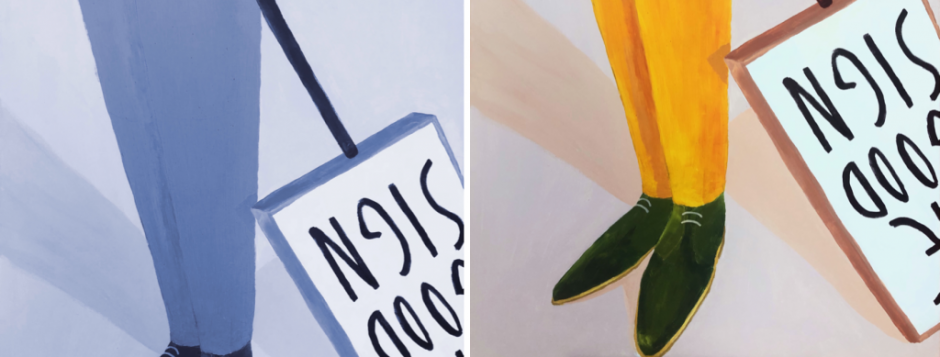Faith & Intersectionality
“What are your values?”, our group tutor asked on the topic of faith. My teammate responded first: ‘I deeply care about equity’, which resonated with me. My answer was ‘I deeply care about empathy as a means to get along with each other.’ Thinking about where those values could stem from, we both drew on being raised by parents we described as science-led thinkers, although we didn’t get the chance to unpick how this informed our values exactly. In my case, I associate science-led thinking with openness to knowledge gain, tolerance, and curiosity. Upon deeper reflection, I found that those characteristics may not be the origin of my values, but rather characteristics I appreciate and trust, reflecting my love for- and trust in my parents. Thus, I came to think, my values might stem from their other embodied and expressed characteristics, such as compassion, humility and respect, grounded in their religious and philosophical beliefs. While I am stemming from a large catholic family, currently my belief is that of agnostic atheism. I phrase this intentionally careful as I have experienced my views and that of my father change over the decades, navigating intense internal conflict on his part. For this reason, I agree with Appiah (2016), who suggests that our religious identities are not rigid, but shaped by the communities we belong to. I view faith as complex and understand, as Appiah (2016) argues, how a narrow view on religion, nationality and other identities might even be harmful.
This teaching year 2024/25, 24 students are enrolled on the course I predominantly teach on, MA Innovative Fashion Production (as an Hourly Paid Lecturer (HPL)). All are Asian, only 12.5% (3 students) are male (see fig 1 and 2). 21 (87,5%) students are non-religious and 12.5% (3 students) prefer not to say (see fig. 3). Out of the latter 3 students, it is unclear if the they have a faith or an absence of faith. This is why it is worth noting that both religion and a lack of religion is protected by UK law, under the Equality Act 2010 (Equality and Human Rights Commission, 2016).



The UK is only recently considered a Post Christian, secular society (see fig. 4) from a long history of predominantly Christian belief (ONS, 2022; Field, 2009), having shaped both government, culture and communities. Although persons of no faith are in some countries discriminated against, such as in the US and some Muslim countries (Humanists International 2024), it does not seem to be a wider issue in contemporary Britain (Gey, 2007). Therefore, I conclude that a person of no declared faith is not subject to systemic discrimination and/ or marginalisation in the UK at the moment. Hence, here, an intersectional assessment is not applicable.

Contrarily, political propaganda in secular societies can cause harm by inflicting systemic discrimination and racism, highlighted by Trinity University’s (2016) speaker on Challenging Race, Religion, and Stereotypes in the Classroom. To navigate religious debates, he suggests to firstly find commonalities and use empathy for creating a diverse community. In his words, “If we can try and understand where people are coming from with empathy […] that allows us to really engage with difference in a way that is constructive rather than destructive.” This empathetic approach resonates with me (see introduction). Further, he recommends to look together with students at the arguments and propaganda used for obtaining or maintaining political power. What are the power interests of leaders? To separate or to unite?
A communality between Dr. Jawad (2022) and Appiah (2016) is that she too warns for stereotyping religion and non-religion (she refers to Islam and the West) being harmful for mutual understanding. Just as Trinity University’s (2016) speaker, she too advocates for education on the topic, specifically with attention to how visibly Muslim women are affected (Jawad, 2022). I will illustrate their dilemma by applying Crenshaw’s (1990) theory of intersectionality, which states that discrimination is not simply the sum of each marginalised characteristic (here: gender plus religion), but is experienced as a distinct form of disadvantage that emerges at the intersection of these identities. Visibly Muslim women aspiring to participate in a sports competitions might not be allowed to compete because of wearing a hijab (religious discrimination). In addition, they might prefer sex-segregated sports grounds but there might be no provision of the option (sex-based discrimination). Together, these identities interact so that the discrimination they face is qualitatively different from what Muslim man or non-Muslim woman might experience. My key take-away concerning the educational setting, is to understand and support faith-based principles, such as dress codes like the hijab and modesty, the need for gender separated spaces.
I found more religious diversity across LCF’s School of Design and Technology, where I teach on some units as well. Although most students are non-religious (60.6%), the largest religious minority is Buddhist with 4.7% followed by Muslim with 3%. Christian present the religious majority with 11.8% (see fig.5).

In my teaching context, it is my responsibility to ensure that all my student’s contributions are taken seriously, regardless of their belief. This includes the expectation that everyone pays attention to making all others feel included. As Fricker’s (2007) work stresses; everyone should be validated equally as a knower (opposed to epistemic injustice), their credibility may not be diminished, particularly by refraining from stereotyped judgement (opposed to testimonial injustice), and by developing an awareness of gaps in collective knowledge that may disadvantage others in the group (opposed to hermeneutic injustice). Tolerance and acceptance have to be embodied. Differences to be embraced.

Word count: ca. 874
References
Aktive Dashboards (2025) UAL data. July 2 Available with provided access at: (Accessed: 2 July 2025).
Appiah, K.A. (2016) Creed. Lecture 1 of Mistaken Identities, BBC Reith Lectures, BBC Radio 4. October. Available at: https://www.bbc.co.uk/programmes/b07z43ds (Accessed: 2 July 2025).
Crenshaw, K. (1990) Mapping the margins: Intersectionality, identity politics, and violence against women of color. Stanford Law Review, 43(6), pp.1241–1299.
Dinic, Milan (2020). “How religious are British people?”. YouGov. 29 December.
Equality and Human Rights Commission (2016) Religion or belief: a guide to the law. [PDF] Available at: https://www.equalityhumanrights.com/sites/default/files/religion-or-belief-guide-to-the-law.pdf [Accessed 2 July 2025].
Field, Clive D. (2009) Universities of Birmingham and Manchester. Religious Statistics in Great Britain: An Historical Introduction (British Religion in Numbers)
Fricker, M. (2007). Epistemic injustice: power and the ethics of knowing. Oxford: Oxford University Press.
Gender Talks (2020) Miranda Fricker On testimony and the power of words 16 June Available at: kyoutube.com/watch?v=VpnzEErB-r8&ab_channel=GenderTalks (Accessed: 11 May 2025)
Gey, Steven G. (2007). “Atheism and the Freedom of Religion”. In Martin, Michael (ed.). The Cambridge Companion to Atheism. Cambridge University Press. pp. 253–255. ISBN 978-0-521-84270-9.
Humanists International (2013) IHEU | New global report on discrimination against the non-religious”. iheu.org. 5 February 2013. Retrieved 10 October 2016.
Humanists International (2024) Available at: https://fot.humanists.international/wp-content/uploads/2024/12/FOTR-PAGE.pdf / https://humanists.international/2025/01/new-report-exposes-the-scale-of-blasphemy-laws-worldwide/ (Accessed: 2 July 2025).
Jawad, H. (2022) Islam, Women and Sport: The Case of Visible Muslim Women. [Online]. Available at: https://blogs.lse.ac.uk/religionglobalsociety/2022/09/islam-women-and-sport-the-case-of-visible-muslim-women/
Office for National Statistics (ONS) 2022. “Religion, England and Wales: Census 2021”. ons.gov.uk. 29 November 2022. Retrieved 13 August 2024.
Robert Evans (2013). “Atheists face death in 13 countries, global discrimination: study”. 9 December. Reuters.
Trinity University (2016) Challenging Race, Religion, and Stereotypes in the Classroom. [Online]. Available at: https://www.youtube.com/watch?v=0CAOKTo_DOk
Tweedle – Own work, data taken from Measuring religious affiliation in Great Britain: the 2011 census in historical and methodological context, using Tables 1 and 3 (up to 1978) and BSA Religious affilation surveys from 1983 to 2018., CC BY-SA 4.0, https://commons.wikimedia.org/w/index.php?curid=128461024 published on Wikipedia: Religion in the United Kingdom.
Bibliography
Appiah, K. A. (2014) Is religion good or bad? (This is a trick question). Youtube [Online]. 16 June. Available at: https://www.youtube.com/watch?v=X2et2KO8gcY
BBC (n.d.) Is there such a thing as western culture? BBC. Available at: https://www.bbc.co.uk/programmes/articles/1M31JT5Jn7CnJKms1XZ3nXb/is-there-such-a-thing-as-western-culture (Accessed: 2 July 2025).
BBC (n.d.) Kwame Anthony Appiah. BBC. Available at: https://www.bbc.co.uk/programmes/articles/2sM4D6LTTVlFZhbMpmfYmx6/kwame-anthony-appiah (Accessed: 2 July 2025).
Field, C. D. (2014) ‘Measuring religious affiliation in Great Britain: the 2011 census in historical and methodological context’, Religion, 44(3), pp. 357–382. https://doi.org/10.1080/0048721X.2014.903643
Wikipedia (2025) Religion in the United Kingdom. Last edited June 20 Available at: https://en.wikipedia.org/wiki/Religion_in_the_United_Kingdom#cite_note-:9-41 (Accessed: 2 July 2025)
Wikipedia (2025) Irreligion in the United Kingdom Last edited June 17 Available at: https://en.wikipedia.org/wiki/Irreligion_in_the_United_Kingdom (Accessed: 2 July 2025)
Wikipedia (2025) Humanists International. Last edited February 5 Available at: https://en.wikipedia.org/wiki/Humanists_International (Accessed: 2 July 2025)
Wikipedia (2025) Discrimination against atheists. Last edited June 21 Available at: https://en.wikipedia.org/wiki/Discrimination_against_atheists (Accessed: 2 July 2025)
Wikipedia (2024) Hijabophobia. Wikipedia, The Free Encyclopedia. Last edited 14 February 2024. Available at: https://en.wikipedia.org/wiki/Hijabophobia (Accessed: 3 July 2025).



Thank you for such an open and considered post. I really appreciated how you grounded your discussion in personal reflection while navigating complex ideas around faith, identity, and pedagogy. Your reflections on agnostic atheism and the fluidity of belief were particularly powerful, and I thought your use of Appiah (2016) to question rigid identity categories was well-placed and thought-provoking.
I also found your use of student data to contextualise your reflections really valuable. It was interesting to see how you drew distinctions between systemic discrimination and social dynamics concerning faith and non-faith, and your example of visibly Muslim women brought intersectionality to life in a clear and relevant way.
One area that might enrich your thinking further is the work of Modood (2019), who explores how secularism in education can still embed forms of marginalisation, particularly when faith-based values are seen as incompatible with liberal academic norms. It might offer a useful counterpoint to your discussion on how atheism is (or isn’t) marginalised in the UK, and expand the lens on institutional frameworks around faith.
Thanks again for a generous and thought-provoking post, lots here that resonated and sparked reflection for my own practice.
Reference:
Modood, T. (2019) Essays on Secularism and Multiculturalism. London: ECPR Press.
Eva, you mentioning Appia’s words and how “our religious identities are not rigid, but shaped by the communities we belong to” has made me reflect on my own set of beliefs and what I bring into my teaching space. Even though I don’t have any set religion I follow and I think I am being neutral in this space, I can never assume that I am. I do have a set of beliefs that might not be religious, but where shaped by my background and positionality. Its important to constantly check if my preconceptions are coming into play when I’m teaching. Thank you for sharing!
This is a great post Eva, I really appreciated the way that you have interwoven your personal lived experience with that of your students, supporting your comments with data. You have underpinned the ideas, beliefs and religious attitudes with your thoughts on empathy, tolerance and acceptance, to generate some thought provoking content, giving me cause to reflect further on my own positionality and attitude to faith.